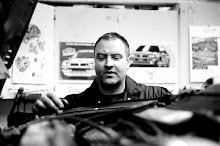
Currently reckoned to be the quickest 16v in the country is our long suffering developement car. It was never intended to be much special, bought as an abandoned project a few years ago when nothing more than stock apart from a partly fitted cage. Every panel on it is a different shade of Rosso 155, but it's relatively rust free and just refuses to die despite us never re-building the engine and it running well over 360bhp on standard internals - a testomony to strength of the Fiat/Lancia Twin cam.

It's been quite enjoyable just to buy someone elses quality part or design and build your own, bolt them on and measure the results, it has got a bit out of hand though and I think a new engine will be completed and fitted sometime this year, more power will be easy - just bolt on a bigger turbo, although if we have time it would be better to do some accompanying mods too. The old 16v has proved a few theorists wrong. Theories smashed were that you won't get stock rods and pistons to cope with over 300bhp, large intercoolers cause lag and that there is no way you will get that amount of power from the stock sized Garret T3 (this output I believe is a world first).
After studying and modifying naturally aspirated engines I applied the same techniques to the turbocharged Lampredi Twin-cam, the basic school of thought here is just as simple: Make the passages which carry air able to carry more, then match it with the equivalent increase in fuel. If you never lose sight of this simple rule you won't fail and if you want maximum efficiency then examine every single restriction and improve it. It really isn't difficult. So how did I go about this?
Well, going backwards from the 3" exhaust, through the equal length ceramic coated tubular manifold into the cylinder head which was gasflowed in house, controlled with bespoke high lift cams we move on to a matched and blended intake manifold with bigger injectors, ported throttle body, 3" intake pipework to the specially designed non restrictive downflow intercooler. Before that comes the stock sized T3 turbo (apart from 360' bearing, staggered oil seal and re-shaped/blended housings) and finally drawn through a rather large and properly sized K&N air filter.
Everything is controlled by a Motec ECU and the engine cooled by an aluminium radiator which incorporates the oil cooler in the same unit.
Ok, there is the occasional slight trade secret here and there in that mix, but there are the basics of it, sound simple? Pretty much so I think, just good old fashioned tuning theory, nothing more. The secret to keeping an engine in one piece is no restrictions, a cool intake charge and a damn good map.
Sadly when the car was mapped we didn't realise we had a small hole in a boost hose, this prevented the engine from receiving the full amount of pressure so we never knew what its genuine output was, you can see the torque and the boost drop off on the graph below. The rolling road we were on had just been recalibrated following it being flooded out in a storm!

Would I recommend anyone push stock engine internals to these limits? Certainly not, this is just an old engine which we bolted some goodies onto to see what they would do, we had to do it this way to prove they worked. If we started from scratch with a whole host of new bits and pieces how would we know what was working well and what wasn't? By building it up this way we know and if the old engine blew it wouldn't be any problem, it owes us nothing.

The suspension is quite special, it features the first of a new generation of Intrax inverted coilovers all round which were built by Intrax and then dialled in specifically on the car by company owner and long time successful circuit racer Hank Thuis, I took it over there for them to work on it and they did a great job.
The front ARB has been shortened to increase its strength, drop links added which connect it to the strengthened suspension arms. A castor kit was also made and fitted. At the rear it features GrpA style transverse suspension arms, diff cradle, lower brace and a 19mm anti-roll bar, I would like to make some forward facing diagonal braces to the front (from the diff cradle to the cills) to finish of the rear and eradicate any movement.
The handling and grip need to be felt to be believed, front to rear traction 'slippage' is controlled by a viscous coupler which we had replenished with new fluid of a higher torque rating, the way it sticks to the tarmac is amazing, understeer is practically non-existant. There are still the Polybushes to get rid of as they are now the weak link, a sensitive driver (not me!) can feel the movement and there are witness marks at the rear where you can see it, some solid bearings will be fitted here this year. What is also helping the car handle is the Sparco cage, it stiffens the shell massively, this along with lightweight composite wings, bootlid and bonnet ensures the suspension does its work properly.
Currently being tested on the car is an aerodynamic front undertray, with more products being designed and made right now.

